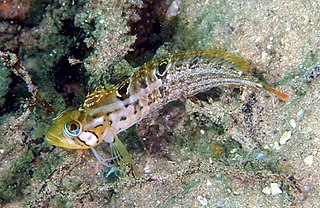
In invertebrates, the term parapodium refers to lateral outgrowths or protrusions from the body. Parapodia are predominantly found in annelids, where they are paired, unjointed lateral outgrowths that bear the chaetae. In several groups of sea snails and sea slugs, 'parapodium' refers to lateral fleshy protrusions.

The prostomium is the cephalized first body segment in an annelid worm's body at the anterior end. It is in front of the mouth, being usually a small shelf- or lip-like extension over the dorsal side of the mouth. The prostomium together with the peristomium, which includes the mouth and pharynx, make up the annelid head.

Cirrhibarbis capensis, the barbelled klipfish, is a species of clinid found in subtropical waters of the Atlantic Ocean around South Africa. This species can reach a maximum length of 36 centimetres (14 in) TL. This species preys primarily on benthic crustaceans, mostly amphipods and isopods. It is currently the only known member of its genus.
Blennioclinus stella, the Silverbubble klipfish, is a species of clinid found in subtropical waters of the southeastern Atlantic and western Indian Ocean along the South African coast down to a depth of about 10 metres (33 ft). This species can reach a maximum length of 5 centimetres (2.0 in) TL.

Blennophis striatus, the Striped klipfish, is a species of clinid found in the subtropical waters of the Atlantic Ocean from Saldanha Bay to East London, South Africa where it can be found in the subtidal zone as well as inhabiting tidepools. This species can reach a maximum length of 17.5 centimetres (6.9 in) TL.

Clinus agilis, the agile klipfish, is a species of clinid found in subtropical waters of the Atlantic Ocean from Namibia to South Africa where it is commonly found in estuaries and tide pools. This species can reach a maximum length of 10 centimetres (3.9 in).
Clinus brevicristatus, the Cape klipfish, is a species of clinid that occurs in subtropical waters of the Atlantic Ocean around South Africa where it prefers habitats with plentiful growth of seaweed. This species can reach a maximum length of 12 centimetres (4.7 in) TL.

Clinus venustris, the speckled klipfish, is a species of clinid that occurs in subtropical waters of the Atlantic Ocean from Namibia to South Africa where it is found in the subtidal zone as well as being a denizen of tide pools. This species can reach a maximum length of 12 centimetres (4.7 in) TL. and feeds primarily on amphipods, isopods, mysids, and echinoderms.

Lanice conchilega, commonly known as the sand mason worm, is a species of burrowing marine polychaete worm. It builds a characteristic tube which projects from the seabed, consisting of cemented sand grains and shell fragments with a fringe at the top.

Nerilla antennata is 1–2 mm colourless meiofaunal polychaete. It is often found in aquaculture.

Thelepus cincinnatus is a species of polychaete annelids in the family Terebellidae, which can be found inhabiting a tube of secrete on rocks and shells. The worm is widely distributed, and can be found in almost any region of the oceans at depths ranging from 10 to 4000 meters.

Scalibregma inflatum, also known as T headed worm, is a burrowing marine polychaete. It is a cosmopolitan species that can be found from the Arctic to Antarctica, although most probably several species are confounded.

Phyllodoce mucosa is a species of polychaete worm in the family Phyllodocidae. It is found intertidally in both the Pacific and Atlantic Oceans, typically on sandy or muddy seabeds.
Eulalia clavigera is a species of polychaete worm in the family Phyllodocidae, native to the coasts around Britain, through Western France, and to the Iberian Peninsula. It closely resembles Eulalia viridis, and there has been confusion in the past as to the identification of the two species.

Scolelepis squamata is a species of polychaete worm in the family Spionidae. It occurs on the lower shore of coasts on either side of the Atlantic Ocean.

Nototropis swammerdamei is an amphipod crustacean of the family Atylidae.

Syllis prolifera is a species of polychaete worm in the family Syllidae. It has a cosmopolitan distribution. It was first described in 1852 by the Russian/German zoologist August David Krohn who gave it the name Syllis prolifera.
Jasmineira elegans is a macrobenthic suspension feeder native to the coastal waters of the Northern Atlantic, Mediterranean Sea, and Red Sea. The worm is sessile and lives in sandy substrates where it utilizes suspension feeding in order to acquire nutrients.

Leucia nivea is a species of polychaete worm, commonly known as a "scale worm", in the family Polynoidae. This species occurs in the northeastern Atlantic Ocean, the North Sea and the Mediterranean Sea.

Poecilochaetus serpens is a species of marine polychaete worm in the family Poecilochaetidae. It is a benthic worm that burrows into soft sediment.
















